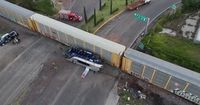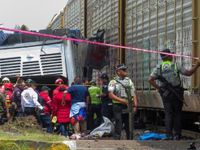Monday morning in Atlacomulco, a bustling industrial town roughly 80 miles northwest of Mexico City, dawned with the usual hum of commuter traffic. But by 6:30 a.m. on September 8, 2025, tragedy struck: a freight train collided with a double-decker passenger bus at a level crossing, killing at least ten people and injuring more than sixty, according to authorities and multiple news outlets including Reuters, The New York Times, and the Associated Press.
The crash, which happened in an industrial zone packed with warehouses and factories, has since become one of the deadliest in recent memory as Mexico pushes forward with ambitious rail expansion plans. Videos circulating on social media and reviewed by Reuters and The New York Times show the bus inching forward in bumper-to-bumper traffic, slowly edging onto the tracks. Seconds later, a freight train operated by Canadian Pacific Kansas City of Mexico (CPKC) barrels into the passenger side of the bus, shearing it in half and dragging the wreckage several meters down the line. The roof of the bus was torn completely off, leaving passengers exposed and desperate. "Help me, help me," a woman cried in the aftermath, her voice captured on video and reported by Al Jazeera.
Images from the scene, published by outlets like Reuters and Xinhua, show the front part of the top deck smashed and the metal frame mangled. The bus, operated by Herradura de Plata, was reportedly carrying 51 passengers, many of whom were headed from a small town in Mexico State to Mexico City for work. Rescue workers quickly cordoned off the area as first responders rushed survivors to local hospitals. Victims ranged in age from 19 to 48, with some in severe condition and others released after treatment, according to Reuters.
The State of Mexico’s attorney general’s office confirmed that among the ten dead were seven women and three men. The office has launched an investigation into the circumstances of the crash. Authorities have not released the names of the victims, but Rebeca Miranda told the Associated Press her sister and her sister’s daughter-in-law were on the bus; her sister survived and was hospitalized, but the daughter-in-law did not. Both women were domestic workers. “It’s really unfortunate. Why? To beat the train. Those are lives,” Miranda lamented to the news agency.
As the investigation unfolds, a key question persists: how could such a devastating collision occur in broad daylight? According to multiple eyewitnesses and video evidence cited by The New York Times and AP, there were no visible crossing gates, stop lights, or warning signals at the intersection. Cars ahead of the bus had managed to cross just moments before, while traffic on the other side was at a standstill. One worker at a nearby service station told Reuters the train sounded its horn well in advance, but with heavy traffic and no clear signals, the warning may have gone unnoticed—or unheeded.
CPKC, the Canadian-based railway operator, confirmed the accident and expressed condolences to the families of the victims. In a statement, the company urged the public to respect signals and avoid risky behavior at crossings. CPKC also claimed the bus was attempting to pass in front of the moving train—an assertion echoed by authorities, who have since taken the bus driver into custody for questioning. The bus operator, Herradura de Plata, did not immediately respond to requests for comment.
Deadly accidents at rail crossings are not new in Mexico, but the frequency is rising. According to Mexico’s Rail Transportation Regulating Agency, grade-level crossing accidents have surged from 602 in 2020 to 800 in 2025. In the first three months of this year alone, there have already been 35 injuries and three deaths in train-vehicle collisions. Last month, six people died in a similar crash in Guanajuato, and in 2019, nine perished when a freight train hit a passenger bus in Querétaro. The agency’s March report cited "driver violation of traffic laws regulating intersections between lines and highways" as the main cause of such accidents, particularly in urban and industrial areas like Atlacomulco.
Mexico’s ongoing expansion of its railway infrastructure adds a layer of complexity to the tragedy. President Claudia Sheinbaum, building on initiatives started by her predecessor Andrés Manuel López Obrador, has declared rail development a national priority. The government has pledged $8 billion for new projects, aiming to double the country’s passenger train lines to nearly 1,800 miles within six years. Sheinbaum has argued that increased rail capacity will create jobs, streamline supply chains, and boost tourism. “We believe that the train will be a great alternative for passenger transportation,” she said in February, touting a new line connecting Mexico City to Querétaro. “Traveling by train will be faster, much more agile and safer than traveling by road.”
But Monday’s crash underscores the challenges of balancing rapid infrastructure growth with safety. While freight trains are common, passenger rail routes remain limited, making buses the primary mode of transportation for millions of Mexicans. The lack of safety infrastructure at crossings—like gates, lights, and audible warnings—has become a glaring concern. Many of the worst accidents have occurred in the state of Mexico and industrial hubs like Nuevo León and Guanajuato, areas that are also focal points of the government’s rail expansion efforts.
For families like the Mirandas, the statistics and political ambitions offer little comfort. As Rebeca Miranda stood by the tracks, waiting for news of her loved ones, the human cost of the tragedy was painfully clear. Local authorities have promised a thorough investigation, and CPKC has pledged full cooperation. Yet, as Mexico pushes forward with its rail ambitions, the need for improved safety measures at crossings—especially in busy, industrialized corridors—has never been more urgent.
Monday’s collision in Atlacomulco serves as a stark reminder that progress and safety must go hand in hand. As Mexico’s trains roll into the future, the lessons of this tragedy cannot be ignored.



